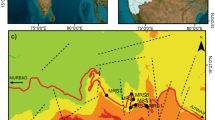Abstract
An analysis is presented of several cut slope failures which occurred in the Triassic “Grés de Silves”, in the area of Areeiro in Coimbra, Portugal. They developed along thin mudstone layers dipping at some 16° towards the face of the excavation. The failures mainly occurred after periods of intense rainfall, sometimes immediately after the excavation of the slope, and in some cases have continued for the 7 years since, even where the slope height was only a few metres. The conditions leading to the failures were investigated in the field and in the laboratory. It was concluded that the main factors inducing the slope failure are a conjugation of the geological structure and the reduction in the shear strength of the mudstones when they dilate following excavation. This dilation allows the ingress of water further reducing the shear strength of the mudstones.
Résumé
Une analyse de plusieurs ruptures de talus de déblais, dans les «Grès de Silves» triasiques, dans le quartier d’Areeiro à Coimbra au Portugal, est présentée. Les ruptures se sont développées le long de couches argileuses de faible épaisseur plongeant à environ 16° vers le talus. Les ruptures sont survenues principalement après des périodes de pluies intenses, parfois immédiatement après l’excavation du déblai. Dans certains cas elles se sont poursuivies durant les sept années suivantes, même lorsque la hauteur du talus n’était que de quelques mètres. Les conditions à l’origine de ces ruptures de talus ont été étudiées sur le terrain et en laboratoire. Il a été conclu que les principaux facteurs responsables de ces ruptures de talus se trouvaient dans la structure géologique et la diminution de la résistance au cisaillement des argiles quand elles se dilatent après excavation, des fissures s’ouvrant alors et favorisant les infiltrations d’eau.
















Similar content being viewed by others
References
Azerêdo AC, Duarte LV, Henriques MH, Manuppella G (2003) Da dinâmica continental no Trásico aos mares do Jurássico Inferior e Médio. Instituto Geológico e Mineiro, 43p (in portuguese)
Chleborad A (2000) Preliminary method for anticipating the occurrence of precipitation-induced landslides in Seattle, Washington. Open-File Report 00-469, U.S. Geological Survey
Hawkins AB, McDonald C (1992) Decalcification and residual shear strength reduction in Fuller’s earth clay. Géotechnique 42(3):453–464
Hocking GA (1976) Method for distinguishing between single and double plane sliding of tetrahedral wedges. Int J Rock Mech Min Sci Geomech 13:225–226
ISRM (2007) Suggested methods for determining water content, porosity, density, absorption and related properties and swelling and slake-durability index properties. In: Ulusay R, Hudson JA (eds) The complete ISRM suggested methods for rock characterization, testing and monitoring: 1974–2006. ISRM Turkish National Group, Ankara, Turkey, pp 143–156
Lemos LL, Quinta-Ferreira M (2004) Elísio de Moura landslide. In: Lacerda, Ehrlich, Fontoura, Sayão (eds) Landslides: evaluation and stabilization. Balkema, 2:1013–1017
Lupini JF (1981) The residual strength of soils, PhD thesis, University of London
Lupini JF, Skinner AE, Vaughan PR (1981) The drained residual strength of cohesive soils. Géotechnique 31(2):181–213
Markland JT (1972) A useful technique for estimating the stability of rock slopes when the rigid wedge slip type of failure is expected. Imp Coll Rock Mech Res Repr 19:1–10
Miranda J, Pina B, Matos V, Calhôa AM, Pena dos Reis R, Pimentel N (2010) Estudo das fácies de leque aluvial em afloramento do Triásico Superior de Coimbra. e-Terra 21(9):4 (in portuguese)
Mitchell JK (1993) Fundamentals of soil behavior, 2nd edn. Wiley, New York
Palain C (1976) Une série détritique terrigène. Les “Grés de Silves”: Trias et Lias inférieur du Portugal. Memórias, Serviços Geológicos de Portugal, Lisboa. 25 (nova série), 377p
Quinta-Ferreira M (2007) Natural and man made causes for the Elísio de Moura soil flow in Coimbra, Portugal. Bull Eng Geol Environ 66(1):35–43. doi:10.1007/s10064-006-0046-1
Quinta-Ferreira M, Quinta-Ferreira T (2004) O problema das instabilizações de taludes em Coimbra. Cadernos de Geografia 21(23):127–142 (in portuguese)
Quinta-Ferreira M, Lemos LL, Pereira LM (2005) Influência da precipitação na ocorrência de deslizamentos em Coimbra, nos últimos 139 anos. Geotecnia 104:17–30 (in portuguese)
Quinta-Ferreira M, Lemos LL, Pereira LM (2006) Influência da precipitação nos deslizamentos e no comportamento dos pelitos do Triásico, em Coimbra. 10° Cong. Nacional de Geotecnia 1:61–72. Sociedade Portuguesa de Geotecnia (in portuguese)
Schuster RL, Highland LM (2007) The third hans cloos lecture. Urban landslides: socioeconomic impacts and overview of mitigative strategies. Bull Eng Geol Environ 66:1–27. doi:10.1007/s10064-006-0080-z
Skempton AW (1964) Long-term stability of clay slopes. Géotechnique 14(2):75–101
Skempton AW (1985) Residual strength of clays in landslides, folded strata and the laboratory. Géotechnique 35(1):3–18
Skempton AW, DeLory FA (1957) Stability of natural slopes in London clay. In: Proceedings of the 4th international conference soil mechanics and foundation engineering, London, vol 2, pp 378–381
Soares AF et al (2007) Folha 19-D, Coimbra-Lousã. Escala 1:50,000. INETI, Departamento de Geologia, Lisboa (in portuguese)
Acknowledgments
This work was funded by the Portuguese Government through FCT – Fundação para a Ciência e a Tecnologia under the project PEst-OE/CTE/UI0073/2011 of the Geosciences Center.
Author information
Authors and Affiliations
Corresponding author
Rights and permissions
About this article
Cite this article
Quinta-Ferreira, M., Andrade, P.S., Lemos, L. et al. Cut slopes failures on the Triassic beds in Coimbra, Portugal. Bull Eng Geol Environ 72, 383–396 (2013). https://doi.org/10.1007/s10064-013-0483-6
Received:
Accepted:
Published:
Issue Date:
DOI: https://doi.org/10.1007/s10064-013-0483-6




